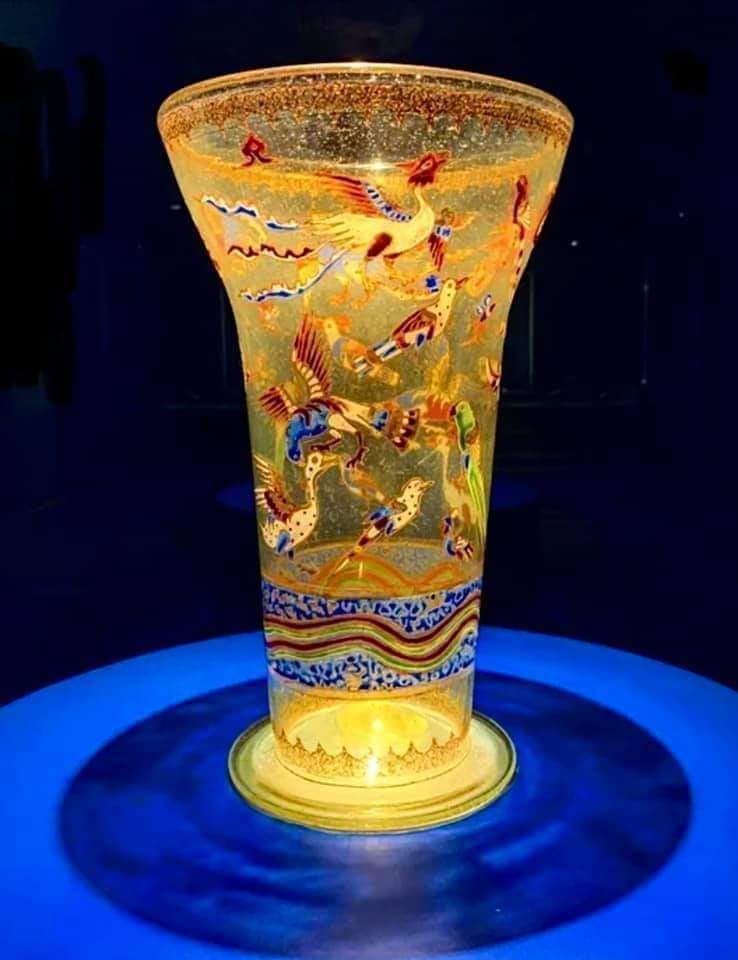Mamluk Enamel and Gilded Glass Beaker, decorated with legendary and real birds, possibly made in Egypt or Syria.
The inscription around the top of this beaker reads, al’-izz li-mawlana al-sultan al-malik al-‘amil …. al-murabit (?) al-muthagir (?) al-mu’ayyad al-muzaffar …., ‘Glory to our Lord, the Sultan, the King, the Diligent … the Defender, the Protector of Frontiers, the One helped [by God], the Triumphant’.

This beaker is a remarkable lyrical survival from the greatest period of manufacture of enamelled Islamic glass. The main band of decoration comprises two large seated figures alternated with cusped cartouches. In its original state, the head of each figure would have been contained within a golden nimbus. Further gilt decoration would have surrounded the figures. The ghosted traces of this indicate that the figures were surrounded by elegant scrolling vine, and that there was a blazon above the outstretched arm of one of the figures. One of the figures holds a long instrument and the other a beaker – not dissimilar in form to the one which he decorates.
.jpg?mode=max)
In terms of the scale of the figures our enamelled beaker relates closely to five of the most remarkable examples that are known. Two of these were in the collection of the Landgraf von Hessen-Kassel one of which, destroyed in the Second World War, depicted mounted hawkers. The other depicts musicians (Rachel Ward (ed.), Gilded and enamelled glass from the Middle East, London, 1998, pl.12.3; and Carl Johann Lamm, Mittelalterliche Gler und Steinschnittarbeiten aus dem nahen Osten, Berlin, 1929-30, pl.127.3). Another, again depicting musicians, is in the Benaki Museum (Christoph W. Clairmont, Benaki Museum catalogue of Ancient and Islamic Glass, Athens, 1977, no.420, p.120 and pl.XXIII). The other two further related examples include one in the Louvre with riders (Europa und der Orient, exhibition catalogue, Berlin, 1989, pl.p.213) and the Palmer Cup at Waddesdon (Ward, op.cit., pl.13.5).
Of those listed above, it is the Palmer Cup that shares the greatest similarity with ours. Not only is the basic decorative arrangement exactly the same – a register of large scale figures, an upper band of naskh inscription reserved against blue ground, and a lower band of similarly treated scrolling vine – but it also shares with ours the exceptional type of enameled and gilded decoration in the frieze of figures, which are moulded in low relief in ‘enamel paste’ before being painted in gold, and in that case also enameled colours (Hugh Tait, ‘The Palmer Cup and related glasses exported to Europe in the Middle Ages’, in Ward, op.cit., p.54). This is also found on the Benaki beaker, which is painted ‘in gilt on embossed red’ (Clairmont, op.cit., p.120). Like ours the Benaki beaker has lost much of its gilding, leaving the figures shadows of their former selves. Many of the glass beakers listed above depict musicians, like a beaker offered in these Rooms, 17 April 2007, lot 50. The Palmer Cup however numbers amongst the six figures depicted around its sides, a ruler, a mace-holder, two spear attendants and castanet players – a full cast for any enthronement scene. On our beaker the figures also seem to be engaged in courtly enjoyment, one of them holding a beaker as on a perfume flask in the Al-Sabah collection (Stefano Carboni, Glass from Islamic Lands, London, 2001, cat.96a, pp.353-54).
.jpg?mode=max)
Both our beaker, the Benaki beaker and that offered in these Rooms in 2007, have a blazon drawn beside the head of one of the large figures. In ours the blazon is now very hard to read, as the gilt in which it would have been drawn has gone. However, from what is visible, it seems that it may be the same as that which decorated our 2007 beaker. Both had a cup surmounted by a table, or disc. Unfortunately it has not been possible to identify the patron.
The Palmer Cup, the Benaki Beaker and those offered in our Rooms, both here and in 2007, are part of the group ascribed to Aleppo by Lamm and since then referred to as the “Aleppo group”. Most authorities date them either in the second half of the 13th century or, more precisely, in the third quarter. Summer Kenesson suggests a revised chronology which would place these in the second quarter of the century, but does not give reasons in sufficient detail (“Islamic Enamelled Beakers: a new chronology”, in Ward, op.cit., pp.45-49).
Related Post
A shocking documentary proves that mermaids do exist
SHOCKING Revelation: Thuya, Mother of Queen Tiye, Was the Grandmother of Akhenaten and Tutankhamun—What Ancient Egyptian Secrets Did She Leave Behind?
Breaking News: Astonishing Discoveries at Karahan Tepe Confirm an Extraterrestrial Civilization is Hiding on Earth, and NO ONE Knows!
Breaking News: Researchers FINALLY Discover U.S. Navy Flight 19 After 75 Years Lost in the Bermuda Triangle!
NASA’s Secret Investigation: Uncovering the Astonishing Mystery of the UFO Crash on the Mountain!
Explosive UFO Docs LEAKED: Startling Proof That Aliens Ruled Ancient Egypt!